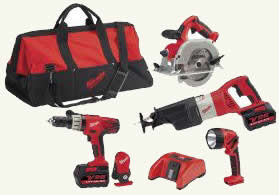If you are considering finally replacing your trusty hedge trimmer or electric drill with a new cordless model, does it pay to spend more for a lithium-ion tool? More manufacturers of cordless rechargeable lawn, garden and construction tools are abandoning nickel-cadmium batteries for lithium-ion, or Li-Ion, cells, which promise lighter weight.

Figure 1 - Lithium-ion cordless tool kit
How you plan on using the tools would play a critical role in that decision. If you're an infrequent, light-duty user, it probably wouldn't make sense to pay a premium for a Li-Ion-powered tool. If you use the tool frequently for longer more heavy-duty tasks, it might make sense to buy a Li-Ion drill.
The latest manufacturers specification reveal that you might need to follow different charging and use patterns with Li-Ion batteries; otherwise they might not last as long as you'd expect. Lithium-ion (Li-Ion) and nickel-metal-hydride (NiMH) batteries are helping cordless lawn and garden tools add power and run time, with less weight for Li-Ion.
Greener design is also a plus, since Li-Ion and NiMH batteries don't contain toxic cadmium, which can leach into groundwater if spent nickel-cadmium (NiCd) batteries are thrown out with trash instead of recycled.
Selection of Li-Ion-powered tools.
How To Choose:
- Not everyone homeowner needs maximum power and run time. Don't go by the stated voltage. Several 18-volt drills had less power than models rated at 14.4 and even 12 volts.
- Look for work-saving features. The newer cordless tools have longer run times, letting you do more work with fewer pauses to charge or change batteries.
- Recharge times of 30 minutes or less are another advantage.
- Check battery prices. Some NiCd replacement cells cost as little as $25 compared with $90 or more for many Li-Ion and NiMH cells which make it more economical to purchase several batteries to extend operating time.
- Some manufacturer are designing power tools so that one battery operates several different tools letting you build a collection with a single power source for less, as shown in Figure 1.
- Skip the gimmicks. Put your hands on it. Hold the tool at shoulder height or higher to be sure it isn't too heavy for overhead work. Check that its grip is free of bumps and sharp edges, and that its trigger works smoothly. Especially with heavier models, be sure the tool feels balanced.
- Be skeptical about specs. Ads and displays often imply that more voltage is better, which isn't necessarily so. You'll also see impressive-sounding torque ratings (in inch-pounds) and maximum speeds (in revolutions per minute). Just don't expect the tool you buy to reach those speeds at home, since manufacturers typically conduct speed tests in the no-load mode - free-running mode.
- While most tools with these new high-tech lithium-ion batteries still sell for more, you'll soon find more lower-priced models as more brands make the switch.
